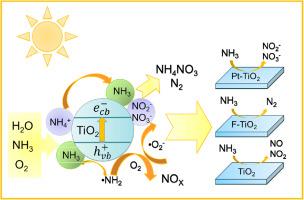Applied Catalysis B: Environment and Energy ( IF 22.1 ) Pub Date : 2021-09-09 , DOI: 10.1016/j.apcatb.2021.120688 Yajie Shu 1, 2 , Jian Ji 1 , Ming Zhou 3 , Shimin Liang 1 , Quan Xie 1 , Sitan Li 1 , Biyuan Liu 1 , Jiguang Deng 4 , Jianping Cao 1 , Shengwei Liu 1 , Haibao Huang 1

|
Ammonia (NH3) as an important precursor to form atmospheric fine particles and secondary inorganic aerosols, should be strictly controlled. Photocatalysis has provided a facile and an effective way to eliminate NH3 pollution under mild conditions, whereas the undesirable products, such as NO, NO2 would be generated during the reaction and the mechanism remains unclear. In this study, F or Pt modified TiO2 were explored to reduce the formation of NOx during photocatalytic oxidation of low-concentration NH3, and its photocatalytic activity, selectivity and mechanism of NH3 conversion were systematically studied. Results indicate that surface fluorination on TiO2 contribute to the reduction of noxious NOx, especially for NO2, since the modified TiO2 achieved enhanced adsorption of NH3 and strong electron-trapping ability, which can retard the recombination of photo-generated electrons and holes. In addition, the deposition of Pt could further extend the lifetime of the electron-hole pairs by strongly capture the electron, and enhance the oxidation of NH3 into nitrates and nitrites species. From the in-situ DRIFT spectroscopy and XPS results, we can deduce that reactive amino radical (•NH2) would be formed on TiO2 under photoirradiation after the adsorption of NH3 on Lewis acid cites. The formed •NH2 can react with reactive oxygen species in the presence of H2O, and produce NOx and HNOx. By both enhancing the adsorption of NH3 and separation efficiency of electron-hole pairs, the presence of F and Pt modification on the TiO2 changes the photocatalytic pathway of NH3 conversion. The proposed selective oxidation mechanism may offer a novel insight into the photocatalytic oxidation of atmospheric NH3 on other metal oxide with surface modification and can be broadly employed in air pollution control in indoor environments.
中文翻译:

Pt和F改性TiO2上ppb级气态氨的选择性光催化氧化
氨(NH 3)作为形成大气细颗粒物和二次无机气溶胶的重要前体,应严格控制。光催化为在温和条件下消除NH 3污染提供了一种简便有效的方法,而反应过程中会产生NO、NO 2等不良产物,其机理尚不清楚。本研究探索了F或Pt修饰的TiO 2以减少低浓度NH 3光催化氧化过程中NOx的形成,并对其光催化活性、选择性和NH 3转化机理进行了系统研究。结果表明,TiO 2表面氟化有助于减少有害NO x,尤其是NO 2,因为改性TiO 2实现了NH 3 的吸附增强和电子俘获能力强,可以阻止光生电子和空穴的复合。此外,Pt 的沉积可以通过强烈捕获电子来进一步延长电子-空穴对的寿命,并增强 NH 3氧化成硝酸盐和亚硝酸盐物种。从原位DRIFT 光谱和 XPS 结果,我们可以推断出,在光照射下,TiO 2吸附 NH 3后会形成活性氨基自由基(•NH 2)。关于路易斯酸的引用。生成的•NH 2在H 2 O存在下可与活性氧反应,生成NO x和HNO x。通过增强NH 3的吸附和电子-空穴对的分离效率,TiO 2上F和Pt修饰的存在改变了NH 3转化的光催化途径。所提出的选择性氧化机制可以为大气NH 3在其他表面改性的金属氧化物上的光催化氧化提供新的见解,并可以广泛用于室内环境的空气污染控制。



























 京公网安备 11010802027423号
京公网安备 11010802027423号